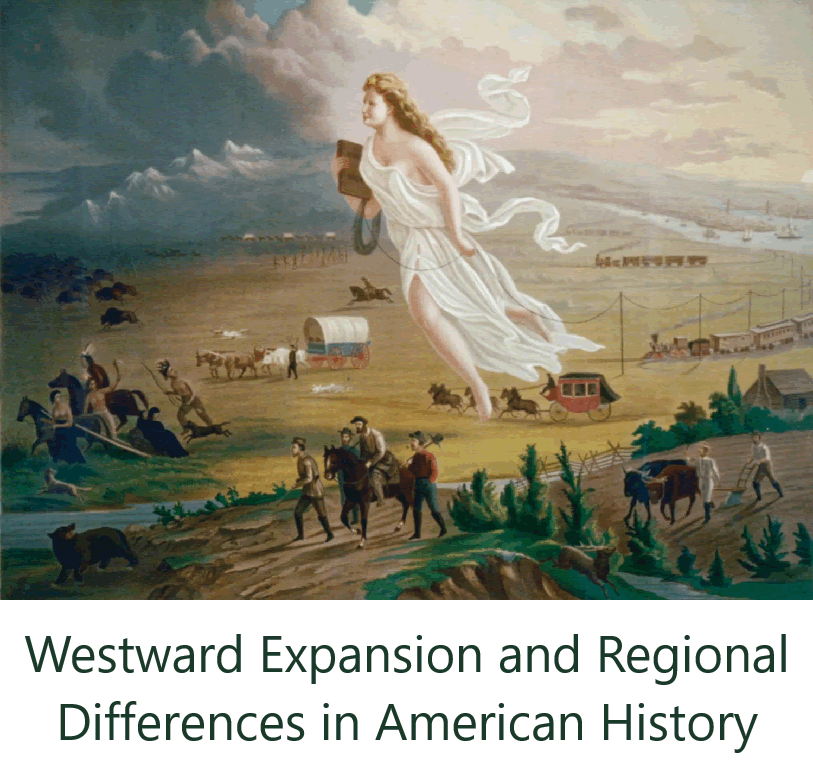Unit V: Westward Expansion and Regional Differences |
|---|
| www.studenthandouts.com > U.S. History > Westward Expansion & Regional Differences |
| Westward Expansion Books & Films | Westward Expansion Miscellany |
| Westward Expansion Image Galleries | Westward Expansion Outlines & Powerpoints |
| Westward Expansion Study Games | Westward Expansion Worksheets |
|
Westward expansion in the United States during the antebellum period (the decades preceding the American Civil War, roughly from the late 18th century to the mid-19th century) was a significant and transformative process that profoundly shaped the nation's geography, society, and politics. This expansion was characterized by the westward movement of settlers, the acquisition of new territories, and the conflicts that arose as the United States expanded its reach across the North American continent. Here are key aspects of westward expansion during the antebellum period.
Manifest Destiny: A prevailing belief during this era was the notion of "Manifest Destiny," the idea that it was the destiny and duty of Americans to expand westward and spread their way of life, including democracy and Christianity, across the continent. This ideology fueled westward expansion efforts.  Louisiana Purchase (1803): One of the most significant events in westward expansion was the Louisiana Purchase. In 1803, the United States purchased a vast territory from France, doubling the size of the nation. This acquisition included the Mississippi River and the port of New Orleans, which were crucial for trade and westward expansion. Louisiana Purchase (1803): One of the most significant events in westward expansion was the Louisiana Purchase. In 1803, the United States purchased a vast territory from France, doubling the size of the nation. This acquisition included the Mississippi River and the port of New Orleans, which were crucial for trade and westward expansion. Lewis and Clark Expedition (1804-1806): President Thomas Jefferson commissioned the Lewis and Clark Expedition, led by Meriwether Lewis and William Clark, to explore the newly acquired Louisiana Territory, map its resources, and establish American claims. They reached the Pacific Ocean, providing valuable information about the region. Oregon Trail: The Oregon Trail became one of the most famous routes of westward migration. It stretched from Missouri to Oregon's Willamette Valley, allowing thousands of settlers to reach the fertile lands of the Pacific Northwest. Santa Fe Trail: The Santa Fe Trail facilitated trade between Missouri and Santa Fe, New Mexico. It played a crucial role in connecting the American West with Mexican territory. Texas Independence and Annexation (1836-1845): Texas, previously a part of Mexico, gained independence in 1836 following the Texas Revolution. It sought annexation by the United States and was admitted as the 28th state in 1845, leading to tensions with Mexico and the Mexican-American War (1846-1848). Mexican-American War (1846-1848): The war with Mexico resulted in the acquisition of vast territories, including California, New Mexico, Arizona, and parts of Colorado, Nevada, Utah, and Wyoming. The Treaty of Guadalupe Hidalgo (1848) formally ended the conflict and established new U.S. borders. Gold Rushes: The discovery of gold in California in 1848 sparked the California Gold Rush, leading to a massive influx of settlers, known as "forty-niners," seeking their fortunes. Similar gold rushes occurred in other regions, including Colorado, Nevada, and Alaska. Transcontinental Railroad: The construction of the First Transcontinental Railroad, completed in 1869, connected the eastern and western coasts of the United States. It facilitated transportation, trade, and migration, further promoting westward expansion. Conflicts with Native American Tribes: Westward expansion often led to violent conflicts between settlers and Native American tribes, as Native lands were encroached upon and their way of life disrupted. Prominent conflicts include the Black Hawk War, the Seminole Wars, and the Sioux Wars. compromises and Political Debates: The issue of westward expansion, especially the extension of slavery into newly acquired territories, was a major source of tension and led to political debates and compromises, such as the Missouri compromise (1820) and the compromise of 1850. Statehood and Territorial Expansion: Numerous new states were admitted to the Union during this period, including Missouri, Arkansas, Michigan, Florida, and Iowa. The process of admitting new states was often influenced by sectional disputes. Environmental and Ecological Impact: Westward expansion had profound ecological effects, including deforestation, overgrazing, and the displacement of wildlife. The transformation of landscapes had long-lasting ecological consequences. Westward expansion played a crucial role in shaping the United States into a continental nation. It brought diverse peoples and cultures together, spurred economic growth, and paved the way for the challenges and conflicts that would ultimately lead to the American Civil War. It also had a profound impact on the indigenous peoples of North America, whose lands and way of life were dramatically altered by the westward movement of settlers. |
| UNIT I: | Early America | UNIT IX: | Discontent and Reform | ||
| UNIT II: | Colonial Period | UNIT X: | War, Prosperity, and Depression | ||
| UNIT III: | American Revolution | UNIT XI: | New Deal and World War II | ||
| UNIT IV: | New National Government | UNIT XII: | Postwar America | ||
| UNIT V: | Westward Expansion | UNIT XIII: | Decades of Change | ||
| UNIT VI: | Sectional Conflict | UNIT XIV: | New Conservatism | ||
| UNIT VII: | Civil War and Reconstruction | UNIT XV: | Into the Twenty-first Century | ||
| UNIT VIII: | Growth and Transformation | UNIT XVI: | Polarization and Deglobalization |
| www.studenthandouts.com > U.S. History > Westward Expansion & Regional Differences |







